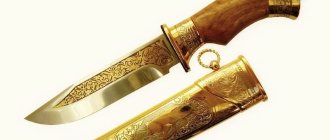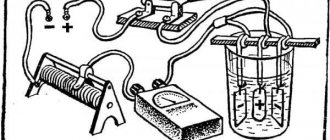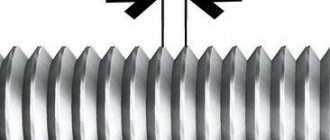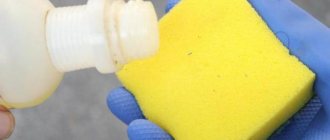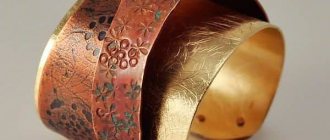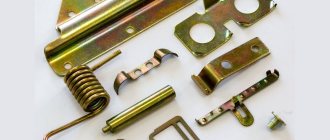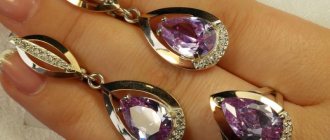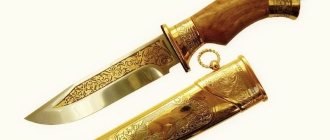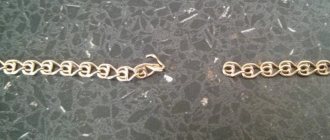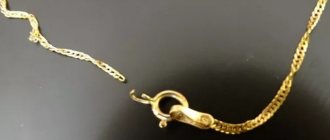By learning how to do gilding at home, which is not as difficult as it might seem at first glance, you can give a second life to your favorite copper and silver jewelry. Products made from gold have been very popular among both women and men for many years. To own such products without significant costs for their acquisition, it is enough to master the technology of gilding.
Both non-ferrous alloys, steel or cast iron can be plated with gold
What metal products can be coated with gold plating?
The most common process is gilding silver, but gold plating can be applied to the surface of other metals. Thus, gilding can be applied to products made of copper, brass and zinc, as well as iron and steel, etc.
There is no clear answer to the question of how to gild metal at home. It all depends on what metal products need to be subjected to such processing. The choice of gilding technology carried out at home is also influenced by the result that needs to be achieved.
With the help of gilding you can give ordinary things a completely different look.
Various methods can be used to gild metal, the most common of which are:
- rubbing the surface of the product with a solution of gold chloride;
- gilding, performed by immersing the product in a solution with a zinc contact;
- galvanic gilding.
Each of these methods of gilding, performed at home, requires the use of certain chemicals, tools and equipment.
Where is it used?
Today, gold plating is used in the following areas:
- jewelry making;
- art (in sculpture; in painting, gilding is used not only on frames, but also directly on paintings);
- Interior design;
- automotive industry (for decorative purposes);
- dentistry;
- electronics (gold is an excellent conductor);
- cosmetology.
The last area of application is the most controversial. Most often, the use of gold in cosmetology is just a cunning marketing ploy. Nevertheless, in Japan they are working on the latest technique of gilding the face. It is believed that this metal enriches the skin with oxygen, preserves collagen and helps relieve irritation.
There is even a separate direction in alternative medicine - chrysotherapy, in which gold is used to treat inflammation. From a scientific point of view, such properties of the metal have not been proven, since a full-scale study of the effect of gold on the human body has never been carried out. But the placebo effect cannot be ignored.
Preparation and use of gold chloride
To gold-plate metal, a solution called gold chloride is often used. To prepare such a solution, gold is dissolved in “aqua regia,” which is a mixture of hydrochloric and nitric acids. Hydrochloric and nitric acids are taken in a ratio of 3: 1. Gold is placed in this composition, and then the liquid is evaporated. The procedure for evaporating liquid from such a solution should be carried out very carefully so as not to cause burns to the skin and respiratory tract. The dry substance remaining after evaporation is precisely gold chloride.
When evaporating, you need to separate the open fire from the container with the solution, for example, by making a layer of asbestos chips poured into a separate container
Before using gold chloride for gilding, it must be mixed with a solution of potassium cyanide and washed chalk, resulting in a paste-like mass. Using a brush, this paste is used to cover the product, after which it is left for some time, and then thoroughly washed and polished.
To gild steel, gold chloride is mixed with ether. The product coated with this composition is left for some time until the ether has completely evaporated, and then the treated surface is simply rubbed with a cloth to impart a golden shine.
Using gold chloride, previously mixed with ether, various inscriptions and patterns can be applied to a metal object. In order to carry out this procedure, a quill pen is dipped into the resulting solution and the required inscriptions and patterns are made, which, after evaporation of the ether and polishing, will sparkle with a golden sheen.
Large surfaces are covered with gold using a soft brush
As mentioned above, gold plating is often applied to silver, for which gold chloride can also be used. To perform chemical gilding of products made from this metal, it is necessary to prepare a mixture that includes the following components:
- gold chloride – 10 grams;
- potassium cyanide – 30 grams;
- table salt – 20 grams;
- soda – 20 grams;
- water – 1.5 l.
Chemical gilding, which must be applied to silver, can also be performed using a mixture of:
- gold chloride – 7 grams;
- potassium ferric sulfide – 30 grams;
- potassium carbonate – 30 grams;
- table salt – 30 grams;
- water – 1 l.
The procedure for sputtering a layer of gold onto a metal surface using chemical solutions is performed in the following sequence.
- The product being processed is pre-calcined.
- The surface of the object is etched first with a solution of sulfuric acid and then with nitric acid.
- The pickled product is momentarily dipped into a mixture consisting of sulfuric, nitric and hydrochloric acids.
- After treatment in a mixture of acids, the product is rinsed with water, then immersed in mercury and finally in water, where it is kept for 30 seconds.
- After a container of water, the product is placed in a solution for gilding, kept for the required time, then washed with water and dried in sawdust.
Application methods
There are many known methods of gilding. The choice is determined primarily by the nature of the surface and the professionalism of the craftsman.
Fire or mercury
One of the very first methods that was used for gilding temple domes. Its essence is that a special mixture based on mercury was prepared, which was subsequently evaporated. Due to the danger to the health and life of the master, this technique is a thing of the past.
Oil based
Another name for the method is Mordan gilding, from the name of a special glue. The method is suitable for both interior and exterior work. Mordan can be purchased in specialized online stores.
Clay based
Clay-based gilding (polyment) is used only for wood and is not suitable for exterior decoration. In the old days, this was one of the most difficult and time-consuming methods, since the preparation of polyment required rare and very expensive ingredients at that time, including whale oil. The mixture was diluted using egg white. Now you can find ready-made mixtures on sale.
Water-synthetic
For this method of gilding, mixtures based on water are used. The advantage is that you can quickly prepare the surface. The gold-plated product is glossy and does not require final polishing.
Garlic
One of the oldest methods. Fresh garlic juice was squeezed onto the surface. After it dried, the surface was polished, moistened and gold leaf was applied. According to experts, this method gives the gilding a special shine.
Application of zinc contact
To obtain a thicker gold-plated layer, a zinc contact is used. Using this method, you can, for example, coat silver with a layer of gold. For gilding, a composition is prepared from the following components:
- gold chloride – 15 grams;
- carbonic potassium salt – 65 grams;
- yellow blood salt – 65 grams;
- table salt – 65 grams;
- water – 2 l.
It will take some time to dissolve all components of the composition
Products made of copper and brass are plated with gold in a solution of the following composition:
- gold chloride – 2 grams;
- caustic potassium – 6 grams;
- potassium cyanide – 32 grams;
- sodium phosphorus salt – 10 grams;
- water – 2 l.
Objects on the surface of which it is necessary to apply a layer of gilding are thoroughly cleaned of dirt and grease, then they are placed in a preheated gilding composition. The products already there are connected to a zinc rod, which acts as a contact.
Compositions of degreasing solutions
In order for the gilding applied to the surface of products made of steel, zinc and tin to be of high quality and have good adhesion, they must be subjected to a copper plating procedure before gilding.
Kinds
The most common type is still gilding. Also in recent years, gold leaf gilding has become popular among decorators, which is much more accessible and cheaper.
Gold leaf
Gold leaf is 960-carat metal, rolled out to a thin sheet. In Rus', gold leaf was traditionally used to cover the domes of churches. In Russia it is sold in the form of books of 60 sheets with an area of 10 cm2 each.
The thickness is not regulated, but the most popular sheets are 10 times thinner than a human hair. It is used to decorate objects of art and for interior design. For outdoor decoration (fountains, domes, sculptures) thicker sheets are used.
Potal
Potal is a replacement for the usual gold leaf. It appears as gold sheets or strips and is an alloy of copper and zinc or aluminum. There is a potal imitating gold, silver and bronze. A drawing can be applied to the sheets. You can find gold leaf on sale in the form of multi-colored crumbs.
What are their differences?
The main difference between gold and gold is that it does not contain precious metal. This naturally affects its price: gold leaf is much cheaper. Without a protective coating, it may fade over time.
When did gilding technology appear?
Gilding is considered the oldest method of decoration, which has not lost its relevance in our time. According to historians, this type of processing of products originated several thousand years ago in Indian and ancient Egyptian territory. In the future, metal utensils, jewelry and architectural fragments were coated with the thinnest layer of gold in eastern countries. It is known for certain that Greek and Roman masters also mastered the technology of applying gold leaf.
On the territory of Rus', gilders appeared in the ninth-tenth centuries AD, when architecture was actively developing. The thinnest layer of gold was then used to decorate buildings both outside and inside. The temple interior looked especially natural with this decoration. Delightful gilded crosses, icon frames, and wall paintings delighted people and instilled special awe in them. And the street church architecture was complemented by the gilding of the domes, which quickly turned into one of the main symbols of the Orthodox faith.
Prices and cost of gilding products in Moscow
- Firstly, custom-made gilding is determined by the area of the coating, how many cm2 it needs to be applied.
- Secondly, the thickness of the layer is of no small importance. Along with it, not only the price increases, but also abrasion resistance.
- Thirdly, the price of metal. The higher the cost of gold per gram, the more expensive it is, accordingly.
- Fourthly, the complexity of the form. Agree, gilding a ring is much easier than, say, a rose.
Prices for gilding in Moscow are not much different from those in other large cities. In the provinces, the main problem is not the price, but the difficulty of finding a good craftsman. While it is still possible to find a jeweler who can gild jewelry, it is difficult to find a professional who can decorate the interior of a home with quality gold. The only exceptions are cities where there are significant ancient monuments, large restoration schools, etc.
You can calculate the exact cost of gilding products by filling out the form below, our master will contact you as quickly as possible and name the exact price of the work.
